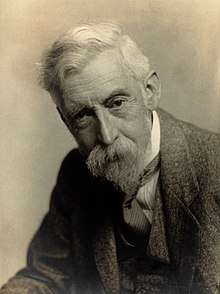Harold John Edward Peake
Harold John Edward Peake or Harold Peake F.S.A (1867–1946) was a British archaeologist and curator for the West Berkshire Museum.[1] With Herbert John Fleure he wrote ten books in the Corridors of Time series covering aspects of archaeology and anthropology as well as several works on his own "Prospector Theory" and other archaeological themes.

Prospector Theory
Peake is most remembered for his "Prospector Theory" of the diffusionism school within anthropology which argues that a group of sea-voyagers from the Eastern Mediterranean sea colonised Europe from c. 2800 BC, introducing the Dolmen.[2] Unlike Grafton Elliot Smith, who believed these maritime colonists were Egyptian, Peake argued that they were descendants of the Sumerians.[3] Peake named this group of sea-voyagers the "Prospectors" based on the fact they were believed to be merchants or traders seeking for ores and metals. This identification was strengthened in Peake's opinion by the fact Bronze Age deposits of metal in Britain were always close by dolmens, an argument also put forward by William James Perry. Peake further maintained that the "Prospectors" were brachycephalic (broad-headed) and racially an intermediate Alpine-Mediterranean people.
Publications
Corridors of Time
- The Corridors of Time: Apes and men (1927, with Herbert John Fleure)
- The Corridors of Time: Peasants and Potters (1927, with Herbert John Fleure)
- The Corridors of Time: Priests and Kings (1927, with Herbert John Fleure)
- The Corridors of Time: Hunters and artists (1927, with Herbert John Fleure)
- The Corridors of Time: The steppe and the sown (1927, with Herbert John Fleure)
- The Corridors of Time: The Way of the Sea (1929, with Herbert John Fleure)
- The Corridors of Time: Merchant Venturers in Bronze (1929, with Herbert John Fleure)
- The Corridors of Time: The Horse and the Sword (1933, with Herbert John Fleure)
- The Corridors of Time: The Law and the Prophets (1936, with Herbert John Fleure)
- The Corridors of Time: Times and Places (1956, with Herbert John Fleure)[4]
Other
- The Bronze Age and the Celtic World (1922)
- The English village: the Origin and Decay of its Community (1922)
- The Origins of Agriculture (1928)
- The Flood: New Light on an Old Story (1930)
- The Archaeology of Berkshire (1931)
- The Early Steps in Human Progress (1933)
Articles
- The Origin of the Dolmen (1916)
Notes and references
- "Harold John Edward Peake, 1867-1946", H. J. Fleure, Man, Vol. 47, Mar., 1947, pp. 48-50.
- "The Origin of the Dolmen", Harold Peake, Man, Vol. 16, Aug., 1916, pp. 116-121.
- The Bronze Age and the Celtic World, Chapter IV: The Prospectors, pp.55-60.
- Herbert John Fleure published the final volume 10 years after Peake's death. The work contains research and writings from Peake never before published.
| Wikisource has original works written by or about: Harold John Edward Peake |